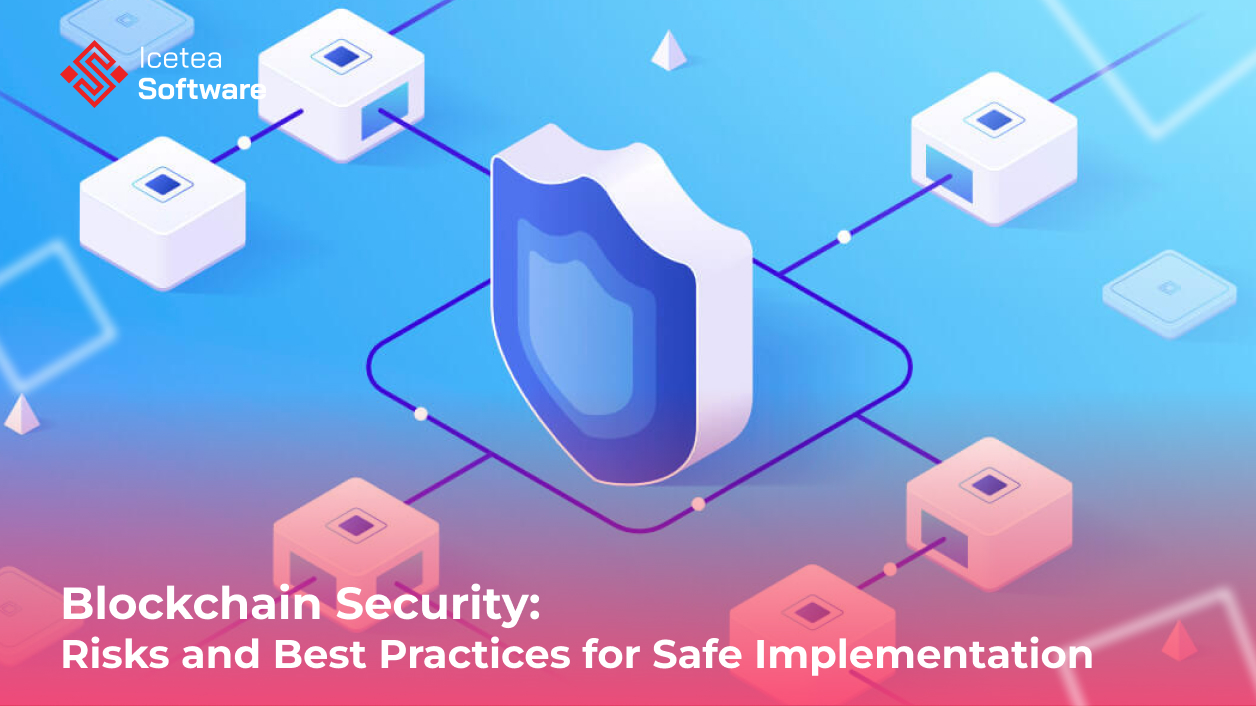Blockchain Security: Risks and Best Practices for Safe Implementation
Blockchain technology, celebrated for its transparency and decentralization, is revolutionizing industries such as finance, supply chain, and healthcare. As businesses increasingly adopt blockchain solutions, it becomes essential to understand not only its benefits but also its potential blockchain security risks. This blog explores the key risks associated with blockchain and offers actionable best practices to…
Blockchain technology, celebrated for its transparency and decentralization, is revolutionizing industries such as finance, supply chain, and healthcare. As businesses increasingly adopt blockchain solutions, it becomes essential to understand not only its benefits but also its potential blockchain security risks. This blog explores the key risks associated with blockchain and offers actionable best practices to secure every link in the chain.
Understanding Blockchain and Its Appeal
At its core, blockchain is a decentralized digital ledger consisting of interconnected blocks, each with a unique cryptographic hash. Each block records transactions, and any new block relies on the hash of the previous one, forming an immutable chain. This structure ensures transparency and trust among participants, as every user can inspect the chain while any tampering becomes immediately evident.
Blockchain’s immutability and transparency make it ideal for verifying information, tracing transactions, and enabling secure exchanges. Analysts project the global blockchain market will grow to $40 billion by 2025, with applications ranging from digital identity verification to decentralized finance (DeFi).
However, the same features that make blockchain attractive also introduce unique security challenges. Let’s examine these risks in detail.
Common Blockchain Security Risks
Phishing Attacks
Blockchain participants use private keys to access and manage their assets. In phishing attacks, malicious actors trick users into sharing their private keys or passwords. Once obtained, attackers can compromise wallets, execute unauthorized transactions, and disrupt blockchain integrity.
Solution: Implement employee training programs to raise awareness about phishing. Educate users on verifying links and avoiding sharing sensitive credentials.
Routing Attacks
Blockchains depend on consensus mechanisms to validate transactions. In routing attacks, hackers intercept data during transmission and isolate blockchain nodes, preventing them from participating in consensus processes. This can lead to delays and vulnerabilities such as 51% attacks.
Solution: Protect blockchain communications with robust encryption and network monitoring tools to detect unusual traffic patterns.
Sybil Attacks
Sybil attacks involve creating numerous fake identities (or dishonest nodes) to manipulate network behavior. These fake nodes can extract sensitive information or block legitimate transactions.
Solution: Implement robust validation systems to authenticate every node. Continuous monitoring and strong access controls can detect and mitigate these attacks.
51% Attacks
In this scenario, attackers control more than 50% of a blockchain’s computational power, enabling them to rewrite transaction history, block new transactions, and perform double-spending attacks. Ethereum Classic, for instance, suffered three 51% attacks in 2020, costing millions in damages.
Solution: Transition from proof-of-work (PoW) to proof-of-stake (PoS) consensus mechanisms, which are less susceptible to such attacks. Additionally, slowing transaction confirmations can make attacks more costly and challenging.
Man-in-the-Middle (MITM) Attacks
In MITM attacks, hackers insert themselves between users and blockchain networks to intercept and alter transactions. By posing as legitimate nodes, attackers can divert funds or steal sensitive data.
Solution: Use end-to-end encryption and ensure all transactions are verified independently before execution.
Endpoint Vulnerabilities
Users often store private keys on personal devices or third-party apps, which can be compromised through malware or theft. Lost or stolen devices may expose sensitive credentials, putting blockchain assets at risk.
Solution: Encrypt devices storing private keys, implement multi-factor authentication (MFA), and enforce rigorous physical security measures.
Smart Contract Exploits
Smart contracts automate blockchain transactions when specific conditions are met. However, poorly written code can expose vulnerabilities. For instance, in 2021, hackers exploited flaws in Poly Network’s smart contracts to steal over $600 million.
Solution: Conduct thorough code audits and use secure development practices. Test smart contracts rigorously and employ trusted libraries during development.
Best Practices for Blockchain Security
To maximize blockchain’s benefits while minimizing risks, businesses should adopt the following best practices:
- Robust Encryption
Encrypt private keys with advanced standards like AES-256. Utilize Elliptic Curve Digital Signature Algorithm (ECDSA)-based signatures to ensure the security and authenticity of blockchain transactions.
- Identity and Access Management (IAM)
Implement IAM solutions to control access to blockchain systems. IAM tools can block unauthorized users and identify suspicious activity through contextual verification. Combining IAM with MFA significantly reduces the risk of phishing and endpoint vulnerabilities.
- Secure Development Practices
Integrate secure coding principles into the blockchain development lifecycle. Regularly audit code for vulnerabilities, employ bug bounties, and simulate attacks through penetration testing. Secure development minimizes the risk of introducing exploitable flaws.
- Multi-Signature Wallets
Use multi-signature (multi-sig) wallets to add an extra layer of security. These wallets require multiple approvals for transactions, preventing single-point failures and unauthorized changes. Multi-sig wallets are particularly useful for businesses handling high-value transactions or managing collaborative processes.
- Fail-Safes and Incident Recovery
Prepare for unexpected events by implementing fail-safes like circuit breakers and emergency stop mechanisms. These systems can halt suspicious transactions, minimizing damage during an attack. Secure backups and robust recovery plans further enhance resilience.
- Regular Audits
Conduct periodic security audits to identify and address emerging vulnerabilities. Review blockchain code, consensus mechanisms, and network configurations. Audits should include penetration testing to simulate real-world threats and assess system defenses.
- Zero Trust Security
Adopt a Zero Trust model to continuously verify the authenticity of users, devices, and transactions. Zero Trust principles ensure that no entity is automatically trusted, reducing the likelihood of insider attacks and unauthorized access.
Blockchain Types and Security Considerations
Understanding the type of blockchain used—public or private—is crucial for assessing its security needs.
- Public Blockchains: Open to everyone and rely on public and private key pairs. They’re decentralized and resilient but face risks like Sybil and 51% attacks.
- Private Blockchains: Limited to specific participants with private key access. While they offer better control and confidentiality, they’re vulnerable to insider threats and centralized attack vectors.
Businesses must tailor their security measures to the type of blockchain they’re using. For example, private blockchains benefit from strict access controls, while public blockchains require robust consensus protocols.
The Future of Blockchain Security
As blockchain technology becomes mainstream, security will remain a critical concern. Emerging innovations, such as quantum-resistant encryption, promise to enhance security. Simultaneously, the increasing adoption of decentralized finance (DeFi) and non-fungible tokens (NFTs) will demand even more robust protections.
To stay ahead, organizations must prioritize proactive security measures, adopt industry best practices, and foster a culture of vigilance. By doing so, they can unlock blockchain’s transformative potential while safeguarding their assets and data.
Blockchain offers immense opportunities for innovation and efficiency. However, without addressing its security challenges, organizations risk compromising the very trust and transparency that make blockchain so powerful. By understanding common risks and implementing best practices, businesses can build secure, resilient blockchain systems ready for the future.
𝐼𝑐𝑒𝑡𝑒𝑎 𝑆𝑜𝑓𝑡𝑤𝑎𝑟𝑒 𝑖𝑠 𝑎 𝑙𝑒𝑎𝑑𝑖𝑛𝑔 𝑊𝑒𝑏3 𝑑𝑒𝑣𝑒𝑙𝑜𝑝𝑚𝑒𝑛𝑡 𝑐𝑜𝑚𝑝𝑎𝑛𝑦 𝑏𝑎𝑠𝑒𝑑 𝑖𝑛 𝑉𝑖𝑒𝑡𝑛𝑎𝑚, 𝑘𝑛𝑜𝑤𝑛 𝑓𝑜𝑟 𝑝𝑖𝑜𝑛𝑒𝑒𝑟𝑖𝑛𝑔 𝑏𝑙𝑜𝑐𝑘𝑐ℎ𝑎𝑖𝑛 𝑠𝑜𝑙𝑢𝑡𝑖𝑜𝑛𝑠 𝑎𝑛𝑑 𝑑𝑒𝑐𝑒𝑛𝑡𝑟𝑎𝑙𝑖𝑧𝑒𝑑 𝑎𝑝𝑝𝑙𝑖𝑐𝑎𝑡𝑖𝑜𝑛𝑠 (𝑑𝐴𝑝𝑝𝑠), 𝑑𝑟𝑖𝑣𝑖𝑛𝑔 𝑖𝑛𝑛𝑜𝑣𝑎𝑡𝑖𝑜𝑛 𝑖𝑛 𝑑𝑒𝑐𝑒𝑛𝑡𝑟𝑎𝑙𝑖𝑧𝑒𝑑 𝑓𝑖𝑛𝑎𝑛𝑐𝑒, 𝑁𝐹𝑇𝑠, 𝑎𝑛𝑑 𝑏𝑒𝑦𝑜𝑛𝑑.
————————————
𝐈𝐜𝐞𝐭𝐞𝐚 𝐒𝐨𝐟𝐭𝐰𝐚𝐫𝐞 – 𝐂𝐮𝐭𝐭𝐢𝐧𝐠 𝐄𝐝𝐠𝐞 𝐓𝐞𝐜𝐡𝐧𝐨𝐥𝐨𝐠𝐢𝐞𝐬
𝐖𝐞𝐛𝐬𝐢𝐭𝐞: iceteasoftware.com
𝐋𝐢𝐧𝐤𝐞𝐝𝐢𝐧: https://www.linkedin.com/company/iceteasoftware/
𝐅𝐚𝐜𝐞𝐛𝐨𝐨𝐤: https://www.facebook.com/IceteaSoftware/
𝐓𝐰𝐢𝐭𝐭𝐞𝐫: https://x.com/Icetea_software






